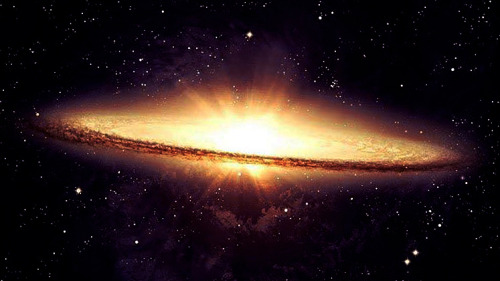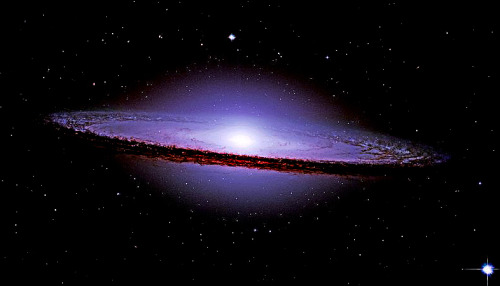2025 January 24

2025 January 24
Comet G3 ATLAS: a Tail and a Telescope Image Credit & Copyright: Yuri Beletsky (Carnegie Las Campanas Observatory, TWAN)
Explanation: Comet C/2024 G3 ATLAS has made a dramatic appearance in planet Earth’s skies. A visitor from the distant Oort Cloud, the comet reached its perihelion on January 13. On January 19, the bright comet was captured here from ESO Paranal Observatory in the Atacama desert in Chile. Sporting spectacular sweeping dust tails, this comet ATLAS is setting in the southern hemisphere twilight and was clearly visible to the unaided eye. In the foreground is the closed shell of one of the observatory’s famous auxiliary telescopes. Still wowing southern hemisphere observers, the comet’s bright coma has become diffuse, its icy nucleus apparently disintegrating following its close approach to the Sun.
∞ Source: apod.nasa.gov/apod/ap250124.html
More Posts from Chbnb and Others




Craters on Moon:
1° From crater Theophilus (100km diameter) below to crater Langrenus above.
2° From bottom to top, dark titanium rich lava in the Sea of Fertility then the diamond shaped patch is the Marsh of Sleep. Small bright crater Proclus is thought to be a recent impact crater and has thrown out bright ejecta that is much lighter than the surrounding ancient weathered rock. Above is the rather hexagonal Mare Crisium.
3° From the Sinus Iridium top left through the Mare Imbrium with the Alpine Valley in the centre. (This original image is horizontal)
4° At the middle and bottom of this image, sunlight is shining on a mountain peak in the Alexander crater which lies beyond the day/night terminator.
Image credit: John Purvis
amazing video

The milky way in WA Australia

This is my first shot of Orion Nebula from home (Nice, France) on Nov 14th. Taken with C8 EdgeHD, Nikon D750, ISO6400,10s. My next step is to fine tune my mount tracking (was done in a rush), take longer exposures and stack several shots. Hopefully this week-end.

Morning mist by Esa Ylisuvanto || Website

Galaxy NGC 2775
Photo Credit: NASA - Hubble Telescope




M104 Sombrero Galaxy

Jamestown, California by Eric Houck

High definition Newly taken shots by NASA Mountain Olympus Mons on Mars, its twice as tall as Mount Everest

Milky Way at Quairading, Western Australia
Nikon d5500 - 50mm - ISO 4000 - f/2.8 - Foreground: 21 x 20 seconds - Sky: 34 x 30 seconds - iOptron SkyTracker - Hoya Red Intensifier filter
-
 naturalwondersandbeauty reblogged this · 1 month ago
naturalwondersandbeauty reblogged this · 1 month ago -
 silvereyedowl reblogged this · 2 months ago
silvereyedowl reblogged this · 2 months ago -
 worldenderr liked this · 2 months ago
worldenderr liked this · 2 months ago -
 sergej963 liked this · 2 months ago
sergej963 liked this · 2 months ago -
 sugarontheblade reblogged this · 3 months ago
sugarontheblade reblogged this · 3 months ago -
 a-dream-seeking-light reblogged this · 3 months ago
a-dream-seeking-light reblogged this · 3 months ago -
 a-dream-seeking-light liked this · 3 months ago
a-dream-seeking-light liked this · 3 months ago -
 silvereyedowl liked this · 3 months ago
silvereyedowl liked this · 3 months ago -
 castcastle liked this · 3 months ago
castcastle liked this · 3 months ago -
 rottenappel liked this · 3 months ago
rottenappel liked this · 3 months ago -
 brilliantstreet liked this · 3 months ago
brilliantstreet liked this · 3 months ago -
 pedro-mc2001 liked this · 3 months ago
pedro-mc2001 liked this · 3 months ago -
 truthofthesignal reblogged this · 3 months ago
truthofthesignal reblogged this · 3 months ago -
 sanlorenzoherald reblogged this · 3 months ago
sanlorenzoherald reblogged this · 3 months ago -
 astrodances liked this · 3 months ago
astrodances liked this · 3 months ago -
 alphafornacis liked this · 3 months ago
alphafornacis liked this · 3 months ago -
 lefoujd liked this · 3 months ago
lefoujd liked this · 3 months ago -
 elusiveladydjinn liked this · 3 months ago
elusiveladydjinn liked this · 3 months ago -
 itssaturntime reblogged this · 3 months ago
itssaturntime reblogged this · 3 months ago -
 itssaturntime liked this · 3 months ago
itssaturntime liked this · 3 months ago -
 tsundoku78 reblogged this · 3 months ago
tsundoku78 reblogged this · 3 months ago -
 tsundoku78 liked this · 3 months ago
tsundoku78 liked this · 3 months ago -
 good-lobster reblogged this · 3 months ago
good-lobster reblogged this · 3 months ago -
 space-bopp-creations liked this · 3 months ago
space-bopp-creations liked this · 3 months ago -
 chris-in-eugene liked this · 3 months ago
chris-in-eugene liked this · 3 months ago -
 fractalist reblogged this · 3 months ago
fractalist reblogged this · 3 months ago -
 calidris liked this · 3 months ago
calidris liked this · 3 months ago -
 bugs-are-buddies liked this · 3 months ago
bugs-are-buddies liked this · 3 months ago -
 chbnb reblogged this · 3 months ago
chbnb reblogged this · 3 months ago -
 chbnb liked this · 3 months ago
chbnb liked this · 3 months ago -
 mymischa liked this · 3 months ago
mymischa liked this · 3 months ago -
 asuperscienceguy reblogged this · 3 months ago
asuperscienceguy reblogged this · 3 months ago -
 asuperscienceguy liked this · 3 months ago
asuperscienceguy liked this · 3 months ago -
 kubernite reblogged this · 3 months ago
kubernite reblogged this · 3 months ago -
 kubernite liked this · 3 months ago
kubernite liked this · 3 months ago -
 shadowsonasphalt reblogged this · 3 months ago
shadowsonasphalt reblogged this · 3 months ago -
 shadowsonasphalt liked this · 3 months ago
shadowsonasphalt liked this · 3 months ago -
 itisthefunpolice reblogged this · 3 months ago
itisthefunpolice reblogged this · 3 months ago -
 capturing-earths-beauty liked this · 3 months ago
capturing-earths-beauty liked this · 3 months ago -
 mckitterick reblogged this · 3 months ago
mckitterick reblogged this · 3 months ago -
 good-lobster liked this · 3 months ago
good-lobster liked this · 3 months ago -
 tophlovesbeer liked this · 3 months ago
tophlovesbeer liked this · 3 months ago -
 s2vpdgga liked this · 3 months ago
s2vpdgga liked this · 3 months ago -
 exapno liked this · 3 months ago
exapno liked this · 3 months ago -
 dabb444 liked this · 3 months ago
dabb444 liked this · 3 months ago -
 waves314 reblogged this · 3 months ago
waves314 reblogged this · 3 months ago -
 ztxtz reblogged this · 3 months ago
ztxtz reblogged this · 3 months ago
